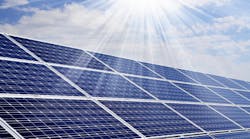Download this article in PDF format.
There was a time when American manufacturers of solar energy products were able to operate profitably within their own borders. In fact, silicon solar cells were invented at Bell Labs in the US in the 1950s. Then, in the 1980s, the nation went on to spend more on solar research and development (R&D) than any other country in the world, according to The Atlantic.
“You wouldn’t know it today,” the publication adds, “but the silicon photovoltaic solar cell—the standard, black-and-copper solar panel you can find on suburban rooftops and solar farms—was born and raised in America.”
Not long after that, the U.S. began to lose its edge in the very market that it had created and cultivated. “Once a solar manufacturing powerhouse, the United States (and the rest of the globe) now depends on China for its solar supply chain,” Solar Power World points out. Credit Chinese ingenuity with a series of trade disputes and tariffs in making the problem worse for American solar manufacturers, many of which found themselves getting severely undercut on price for their products.
“As of February [2022], most U.S. polysilicon factories had been idled or repurposed to supply the semiconductor industry, according to the DOE. The country had no active ingot, wafer or cell capacity, and little panel assembly,” S&P Global Market Intelligence reports. “China, meanwhile, accounts for between 70% and 98% of the world’s production capacity of the silicon-based raw material and components in solar panels.”
The solar supply chain has long been reliant on products from China, or from Chinese subsidiaries in Southeast Asia, pv Magazine reports. “As of 2021, China was responsible for manufacturing a dominant share of the solar supply chain.”
Right now, for example, the solar industry is experiencing a critical shortage in polysilicon due in part to a major manufacturer in Xinjiang, China being closed unexpectedly for repairs. The publication says the Xinjiang region in western China is the origin of nearly 50% of the world’s supply of polysilicon, and it is currently under scrutiny for allegations of forced labor.
“The United States has domestic polysilicon production capacity,” pv Magazine notes. “However, as of 2021 it was not being used for solar applications – but that may be changing.”
A Power Shift May be Coming
According to WSJ, Italian energy company Enel SpA is planning a “solar-manufacturing push” in the U.S., where it will build a factory that makes solar cells “a key part of the supply chain that currently doesn’t exist here.” The factory will ultimately be able to product as much as 6 gigawatts of solar panels.
WSJ says the factory will also manufacture solar cells—products that haven’t been made on U.S. soil since the final few manufacturers either left the business or were priced out of the market by less-expensive imports in recent years. The publication says some of the equipment shortages that emerged during the global pandemic are also driving manufacturers to bring more solar equipment production back to the U.S.
More recently, issues like shutdowns in major metropolitan hubs like Beijing due to new COVID outbreaks, have pushed companies to rethink their reliance on Chinese-made goods. “Another factor in driving more local manufacturing is soaring demand for solar power in the US and worldwide,” WSJ notes, “as governments push to increase the amount of power generated by sources that don’t emit the large amounts of greenhouse gas that fossil fuels do.”
Getting Onboard
The momentum in the U.S. solar manufacturing market appears to be picking up speed. This month, First Solar—the largest American solar panel maker—announced that it had selected Lawrence County, Ala. as the location for its fourth American photovoltaic (PV) solar module manufacturing facility.
The company says the new factory is part of a previously announced investment in scaling First Solar’s American manufacturing footprint to over 10 gigawatts (GW)DC by 2025. The new plant is expected to create more than 700 new direct jobs for Alabama and represents an investment of approximately $1.1 billion. The plant is expected to be commissioned by 2025.
First Solar is also investing $185 million to upgrade and expand its Northwest Ohio manufacturing footprint and plans to invest approximately $270 million in a dedicated R&D innovation center in Perrysburg, Ohio. The company says its new facility will “accelerate American leadership in the development and production of advanced thin film photovoltaics.”









